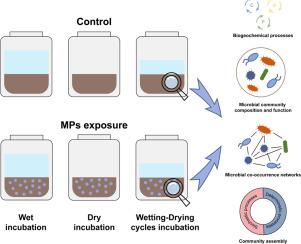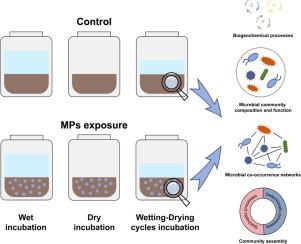Different wetting states in riparian sediment ecosystems: Response to microplastics exposure
IF 11.4
1区 环境科学与生态学
Q1 ENGINEERING, ENVIRONMENTAL
引用次数: 0
Abstract
Climate change alters the wetting state of riparian sediments, impacting microbial community response and biogeochemical processes. Microplastics (MPs) invade nearly all ecosystems on earth, posing a significant environmental risk. However, little is known about the response mechanism of MP exposure in sediment ecosystems with different wetting states under alternating seasonal rain and drought conditions. In this study, sediments with three different wetting states were selected to explore the differential response of ecosystems to PLA MP exposure. We observed that PLA MP exposure directly affected biogeochemical processes in sediment ecosystems and induced significant changes in microbial communities. PLA MP exposure was found to alter the composition of key species and microbial functional groups in the ecosystem, resulting in a more complex, interconnected, but less stable microbial network. Our findings showed that PLA MP exposure enhances the contribution of stochastic processes, for example the dispersal limitation increasing from 7.41 % to 54.32 %, indicating that sediment ecosystems strive to buffer disturbances from PLA MP exposure. In addition, 87 pathogenic species were detected in our samples, with PLA MPs acting as vectors for their transmission, potentially amplifying ecosystem disturbance. Importantly, we revealed that submerged sediments may present a greater environmental risk, while alternating wet and dry sediments demonstrate greater resistance and resilience to PLA MPs pollution. Overall, this study sheds light on how sediment ecosystems respond to MP exposure, and highlights differences in sediment response mechanisms across wetting states.


河岸沉积物生态系统的不同湿润状态:微塑料暴露的响应
气候变化会改变河岸沉积物的湿润状态,影响微生物群落的反应和生物地球化学过程。微塑料(MPs)几乎侵入了地球上所有的生态系统,对环境构成了重大风险。然而,在季节性降雨和干旱交替的条件下,不同湿润状态的沉积物生态系统暴露于 MP 的反应机制却鲜为人知。本研究选择了三种不同湿润状态的沉积物,以探讨生态系统对聚乳酸多孔质暴露的不同反应。我们观察到,暴露于聚乳酸多巴胺会直接影响沉积生态系统的生物地球化学过程,并诱导微生物群落发生显著变化。我们发现,暴露于聚乳酸多巴胺会改变生态系统中关键物种和微生物功能群的组成,从而形成一个更加复杂、相互关联但不太稳定的微生物网络。我们的研究结果表明,暴露于聚乳酸多巴胺会增强随机过程的贡献,例如扩散限制从7.41%增加到54.32%,这表明沉积物生态系统努力缓冲暴露于聚乳酸多巴胺所带来的干扰。此外,在我们的样本中还检测到了 87 种病原体,聚乳酸多孔塑料是这些病原体的传播媒介,可能会扩大对生态系统的干扰。重要的是,我们发现水下沉积物可能会带来更大的环境风险,而干湿交替的沉积物则对聚乳酸多聚物污染具有更大的抵抗力和复原力。总之,这项研究揭示了沉积物生态系统如何应对MP暴露,并强调了不同湿润状态下沉积物响应机制的差异。
本文章由计算机程序翻译,如有差异,请以英文原文为准。
求助全文
约1分钟内获得全文
求助全文
来源期刊

Water Research
环境科学-工程:环境
CiteScore
20.80
自引率
9.40%
发文量
1307
审稿时长
38 days
期刊介绍:
Water Research, along with its open access companion journal Water Research X, serves as a platform for publishing original research papers covering various aspects of the science and technology related to the anthropogenic water cycle, water quality, and its management worldwide. The audience targeted by the journal comprises biologists, chemical engineers, chemists, civil engineers, environmental engineers, limnologists, and microbiologists. The scope of the journal include:
•Treatment processes for water and wastewaters (municipal, agricultural, industrial, and on-site treatment), including resource recovery and residuals management;
•Urban hydrology including sewer systems, stormwater management, and green infrastructure;
•Drinking water treatment and distribution;
•Potable and non-potable water reuse;
•Sanitation, public health, and risk assessment;
•Anaerobic digestion, solid and hazardous waste management, including source characterization and the effects and control of leachates and gaseous emissions;
•Contaminants (chemical, microbial, anthropogenic particles such as nanoparticles or microplastics) and related water quality sensing, monitoring, fate, and assessment;
•Anthropogenic impacts on inland, tidal, coastal and urban waters, focusing on surface and ground waters, and point and non-point sources of pollution;
•Environmental restoration, linked to surface water, groundwater and groundwater remediation;
•Analysis of the interfaces between sediments and water, and between water and atmosphere, focusing specifically on anthropogenic impacts;
•Mathematical modelling, systems analysis, machine learning, and beneficial use of big data related to the anthropogenic water cycle;
•Socio-economic, policy, and regulations studies.
 求助内容:
求助内容: 应助结果提醒方式:
应助结果提醒方式:


